
Unlike Apple.com, the Celluloco.com Galaxy Gear Store accepts your foreign credi card and will ship your Samsung order to anywhere in the Caribbean or to your freight forwarder in the U.S.

You subscribe to either Verizon or Sprint and lost and/or damage your phone and don't want to pay what your carrier asks you for a replacement phone? Come to us! Not only will we offer you a replacement phone for less money than what the carrier would charge you when you're not signing a new contract or doing upgrade. What 's even cooler? The choices we offer are far more advanced than the ones you will see in your neighborhood store!.

Because where are direct factory authorized resellers to the Caribbean by Apple, you can rest assure that you will not find a truer form of a factory unlocked iPhone 4 anywhere else on the web. Unlike others, we ship all of our factory unlocked iPhone 4's factory sealed in the Apple shrink wrap so that you know that your mobile has never been touched by anyone other than Apple itself.

No other site online offers you with a wider variety of colors and versions of the latest Unlocked Blackberry launches in the international mobile arena. Far beyong the capabilities of the U.S>' FCC, Celluloco.com 's relationshiop with RIM in Europe and Asia empowers us to bolster models never yet seen in any store in the U.S., often times quite before any American mobile carrier even decides to carry such model. Widen your blackberry horizon with Celluloco.com.today!

We're sure that you have heard the hype somwhere in the grapevine of just how cool and powerful the new mobile O.S. launched by Google truly is........We do....We all know it as Android! You will be mesmerized with just how comprehensive Celluloco.com arsenal of DROID mobiles did get over the year 2010. In 2011, we predict that at least 70% of all of our unlocked mobile sales will come from Android O.S. powered mobiles....Get with the program...What are you waiting for?.

 Friday, January 24, 2014
Friday, January 24, 2014
 Unknown
Unknown

 Friday, August 19, 2011
Friday, August 19, 2011
 Unknown
Unknown

 Friday, December 11, 2009
Friday, December 11, 2009
 Unknown
Unknown
Opera may be the underdog of desktop browsers but they have a strong foothold in the market. Now, they are expanding their reach by introducing Opera Mobile for Android and the BREW platform - they get the latest Opera Mobile version 10.

Opera Mobile 10 is already out in beta form for Windows Mobile and for Symbian and the feature phone favorite Opera Mini 5 beta 2 is available for download too. The Android and BREW version are only available for operators and OEMs for now. Apparently, there are "limitations that hinder mass consumer distribution". We're guessing it has more to do with the licensing agreements than the platforms capabilities.
Opera are very proud that with Opera Mobile 10 (and Opera Mini 5) they've converged the interfaces - check out the screenshots, they look exactly alike. For the regular user that probably doesn't mean much, unless they have two phones running different OSes, but for carriers and OEMs it will simplify customer support.

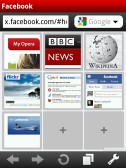
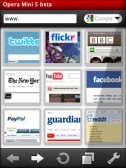
Opera Mobile running of Symbian... Windows Mobile? Is it Opera Mini?
Anyway, we're excited to see Opera Mobile come to Android - especially if it sports the Turbo mode. There already is a port of Opera Mini 4.2 for Android but it's not the same - v4.2 lacks a lot of the goodies of version 5.
It's good news for the BREW platform too, we guess. At the very least, when the rumored HTC Touch.B comes out, it's guaranteed to have a decent browser .
.
 Monday, September 14, 2009
Monday, September 14, 2009
 Unknown
Unknown
The LG first handset to run on the Android OS is already a fact. Today LG have announced the GW620 - a touchscreen handset with a side-sliding full QWERTY keyboard. The company obviously didn't see any need for publishing the specs of the device, save for the size of the touchscreen.
first handset to run on the Android OS is already a fact. Today LG have announced the GW620 - a touchscreen handset with a side-sliding full QWERTY keyboard. The company obviously didn't see any need for publishing the specs of the device, save for the size of the touchscreen.
We are looking at a 3-inch unit here that should start selling in the last quarter of the year and that's about as much as we can get from LG.
Rumor has it though that the LG GW620 will also sport a 5 megapixel camera, GPS and HVGA (480 x 320 pixels) resolution for the display. Additionally the appearance of the handset on the Wi-Fi Alliance web page suggests that it will also pack WLAN.
web page suggests that it will also pack WLAN.
Unfortunately LG decided to spare us the details and leave us guessing for at least a couple of more months, focusing most of the press release on their Windows Mobile products. LG obviously don't want to rock the boat of their Microsoft relationship but then again why did they even bother announcing the LG GW620 in the first place.
Maybe they should have just quietly shipped it to the market to make sure that no one at the Microsoft HQ loses their sleep.
 Monday, August 24, 2009
Monday, August 24, 2009
 Unknown
Unknown
HTC is in the forefront of modernizing Windows Mobile and they're the driving force behind the hardware of most Android phones (and a new UI as of recently). They're not showing any signs of backing down on either platform and seem to have two new entry-level handsets under way, one for each OS - the HTC Mega and HTC Click.
The HTC Click is yet to be announced but that didn't stop the Leak Fairy from bringing us photos and specs. It's a touchscreen bar, roughly the same size as the HTC Magic - a bit shorter, a bit wider and just as thick. It runs Android OS ver. 1.5 (a.k.a. Donut) and lacks Sense UI, which probably indicates it will be a "Google Experience" phone.
The rest of the specs of the HTC Click include a microSD slot, a 3.5mm audio jack and a 1100mAh battery. There's also the standard miniUSB port. We're not quite sure what resolution the camera shoots in but it's obvious it doesn't have a flash.
The touchscreen on the HTC Magic is bigger than the one on the Click but we're not sure by how much (we guesstimate it's about 2.8"). The typical Android buttons are available bellow the display, but the trackball was replaced by a D-pad - making the HTC Click the second Android phone with a D-pad ever (the first is the Samsung I7500 Galaxy).
The second HTC phone for today is the HTC Mega. Don't get confused, the "mega" here doesn't stand for "mega expensive", quite the opposite actually. You can say it's the HTC Touch 3G freshened up. It has the same wireless capabilities - quad-band GSM/EDGE and dual-band HSPA (up to 7.2Mbps), Wi-Fi, Bluetooth 2.0 and GPS.
The biggest change is the OS - Windows Mobile 6.5. Physically, it's almost the size of the Touch 3G, but the HTC Mega is almost 2 mm thinner - 104x55x12.8 mm. It has the helpful home, menu and back keys and a touch zoom bar like on the Touch Diamond2. The rest of the specs are almost identical as well - the same 528MHz CPU, RAM got bumped up to 256MB, a 2.8" QVGA touchscreen, with 3.2 fixed-focus camera and microSD card slot. Even the battery is the same at 1100mAh.
 Monday, August 17, 2009
Monday, August 17, 2009
 Unknown
Unknown
Another big name in the computer industry is dipping their toes in the mobile phone market - Dell unveiled the Dell Mini 3i at an event on which China Mobile presented their online mobile store.
The spec sheet of the Dell Mini 3i is a bit self-contradicting. First off, it runs the China Mobile developed OMS - Open Mobile System, which is based on Android with TD-SCDMA phones in mind (TD-SCDMA is China's own 3G brew). The Mini 3i isn't 3G capable, just 2G GSM and doesn't count on Wi-Fi or WAPI - Chinese equivalent of Wi-Fi (those Chinese sure like homegrown solutions). Bluetooth is the only local wireless connectivity method.



Live shots of the Dell Mini 3i
China Mobile launched an online store offering media, games and apps, which makes the lack of any sort of fast connection to the Interned a real downer. The store will cater a list of manufacturers including Nokia, Samsung and LG - plus apparently Dell. You can find the store at www.mmarket.com (it didn't work for us but it may be a regional sort of thing).
The screen of the Dell Mini 3i is 3.5" capacitive touchscreen with 360 x 640 pixels resolution. This resolution is a first for Android (OK, technically this isn't pure Android but still).
While the touchscreen nature of the device sets the tone for the design, there's something interesting about the front of the Mini - no keys. Vanilla Android is usable without the keys, but just barely, so the OMS interface will probably be very different - reportedly, it's inspired by the iPhone (rather unsurprisingly). An ambient light sensor adjusts the backlight automatically.
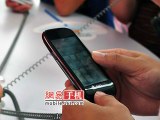
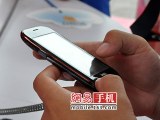
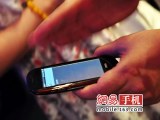
Some more shots of the Dell Mini 3i
The camera on the Mini 3i is a 3-megapixel one with LED flash. There's a microSD card slot for storage. If OMS is anything like Android, it'll have a really tough time doing almost anything without a card so the slot is pretty much a necessity.
A miniUSB port handles PC connectivity but whether it will be able to charge the phone is still not known.
The specs so far read as rather low-end, save for the screen, so the built-in GPS comes as a pleasant surprise, and one of the Mini 3i's saving graces.
It's hard to tell if we'll ever see the Dell Mini 3i outside China, the launch date is not know either. Perhaps it depends on how well it performs, but more likely, it will stay China-only and Dell's next attempts will be the ones that manage to get across the Great Wall (if any).
 Monday, August 10, 2009
Monday, August 10, 2009
 Unknown
Unknown
. Allegedly, Motorola is readying a new Android UI and their rumored Motorola Morrison finally got some specs to look at. The hardware specs seem to put it in the same ring as the other Android-powered devices.
The Motorola Morrison will have a 528MHz CPU and 256MB RAM (the Hero has 288MB), the screen is HVGA - 320 x 480 pixels - practically all Android phones use this resolution. The autofocus camera has 5 megapixels resolution. Wi-Fi, Bluetooth and GPS are covered too as well as smaller goodies such as accelerometer, 3.5 mm audio jack, microUSB port, proximity and ambient light sensor. The internal memory is expandable by microSD cards up to 32GB.
What really sets the Motorola Morrison apart is the side slide-out QWERTY. So far the specs claim only a QuickOffice viewer, but that keyboard would be a huge plus if Motorola goes for an editor instead just a viewer.

Motorola Morrison running vanilla Android (photo: Phandroid)
It seems that the new Android Morrison will run on a new custom Android UI developed by Motorola and called Blur. Heavily web-oriented, it will give users quick access to popular sharing websites. No surprise, Android is quite a web-oriented platform to begin with, but Motorola is adding a touch of social networking - combining your personal contacts with info from social networking sites, a la WebOS (HTC did it too with Hero's Sense UI to some extent). The OS will be upgradeable over the air but more importantly it seems that it will feature push updates.
It's not a giant leap of faith to think that the Motorola Morrison will run this new UI and the Heron (headed to AT&T) is a likely candidate too - it's the one that is undergoing an interesting "sex change" - from Windows Mobile to Android.
The Morrison is rumored to come out on 21 October with specs indicating quad-band GSM support and tri-band 3G but in two versions - 900/1700/2100MHz and another one at 900/1900/2100MHz.
 Wednesday, June 24, 2009
Wednesday, June 24, 2009
 Unknown
Unknown
Quite as expected today HTC officially announced their third Android-running handset - HTC Hero. Sporting the most complete feature set of the three it is destined to battle it out with Samsung I7500 for the full-touch Android throne.
The new HTC Hero runs on the familiar Qualcomm's MSM7200A chipset, with a 528MHz CPU, 288MB of RAM and 512 MB of ROM. Just like the HTC Magic and the HTC Dream, the Hero sports a 3.2" TFT LCD touchscreen display of HVGA resolution (320 x 480 pixels). However this time it will use the capacitive technology and will support multi-touch as visible from the demo video published by HTC (embedded further down this article).
Connectivity is perfectly covered with the HTC Hero as it will feature quad-band GSM and dual band UMTS (with HSPA) support as well as built-in GPS receiver and a Wi-Fi antenna. The mandatory USB and Bluetooth are present too.

The final attention-grabbing features of the HTC Hero are a 3.5mm standard audio jack, a microSD card slot and a built-in accelerometer.
HTC Hero pioneers the new custom UI that HTC have prepared for the Android OS. HTC Sense is based on three basic principles dubbed as Make it Mine, Stay Close and Discover the Unexpected. Here are the three principles as HTC explain them.
Make It Mine
Make It Mine, is about feeling your HTC phone was created for and by you. To do this, HTC encourages you to dictate and organize how you want to access the people and content in your life in a way that fits best for you. For some, this means adding glance view widgets that push content like twitter feeds, weather and other content to the surface while others may want quick access to business-focused information like email, calendar and world-times. HTC is also introducing a new profile feature called Scenes that enables you to create different customized content profiles around specific functions or times in your life.
Stay Close
Today, staying in touch with the people in your life means managing a variety of communication channels and applications ranging from phone calls, emails, texts, photos, status updates and more. HTC Sense takes a different approach by integrating these communication channels and applications into one single view enabling you to stay closer to your important people. With HTC Sense, friends Facebook status updates and photos along with their Flickr photos are included along side their text messages, emails and call history in a single view.
Discover the Unexpected
Many of the most memorable moments in your life are experienced, not explained. HTC Sense is focused on providing a variety of these simple yet innovative experiences on your HTC phone that will sometimes bring you moments of joy and delight. It can be something as basic as turning the phone over to silence a ring or as simple as improving the smart dialler for making calls quicker. HTC Sense also includes perspectives, a new way for viewing your content such as email, photos, Twitter, music and more in different ways.
HTC Hero will be available in three color versions - White, Brown and Graphite (Orange exclusive), with the white one coming with fingerprint-resistant Teflon coating. It will hit the European shelves in July with Asia and North America following later this year.
 Wednesday, June 17, 2009
Wednesday, June 17, 2009
 Unknown
Unknown
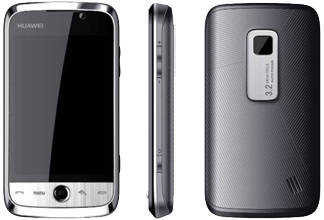
The Chinese-based manufacturer Huawei teased us with a dummy of their future Android phone back in February at the MWC 2009, but this time it's the real deal - it even has its own model name, the U8230.
It's not the first time we're hearing of Huawei's plans on stepping into the Android world but now they probably actually have a working phone to showcase.
Aside from running the Android OS ver. 1.5, the new Huawei U8230 also sports a large 3.5-inch touchscreen, 3.2 megapixel snapper and powerful 1500 mAh battery.
As a true Android device, the U8230 comes with apps like Google Maps, Google Search, Google Talk.
The other features of the Huawei U8230 haven't been revealed yet but since the smartphone is expected to hit the shelves some time in the second half of 2009 we should hear more of it in the near future.
 Thursday, May 28, 2009
Thursday, May 28, 2009
 Unknown
Unknown
At an Android developer's conference called Google I/O, the company handed thousands of Google Ion phones the the attending developers for free. Google Ion, of course, HTC Magic, running Android and in a fancy new outfit.
The Google Ion is obviously hardware and design-wise identical to the Vodafone-exclusive HTC Magic smartphone. However it's got the Google I/O conference logo on the back, it comes in shiny black/blue and the retail package has a SIM card with 1-month T-Mobile service, which initially led us to believe that it's c-branded by T-Mobile USA (but guess what, it's not).
The difference from the T-Mobile G1 comes with the bundled OS update (Cupcake) and the lack of a hardware keyboard.
There also seems to be more good news for Android lovers on the horizon. According to Andy Rubin, senior director for Mobile Platforms for Google and the spearhead of the Android operating system, there will be at least 18 Android-running phones on the market by the end of the year. That number might also go as high as twenty, coming from eight or nine different manufacturers.
And finally, Google announced their next Android Developer challenge. Participating developers will be able to submit applications in a total of 10 categories starting in August.
The Android users will vote the applications and rate them in order to get the 200 best in the final round.
The prizes range up to 100 000 US dollars for each category plus up to 150 000 US dollars for the three over all winners.
You can learn more about the second Android Developer Challenge here.
 Friday, May 01, 2009
Friday, May 01, 2009
 Unknown
Unknown
It looks like our ninja took it personally yesterday when we mentioned how eager we were for more info on Motorola’s Verizo n-bound handsets. That said, consider us shut up. He swooped in with a few big updates that will definitely tide us over for a while — some good news and some bad — so let’s get right to it… First and foremost, the Calgary will indeed be Motorola’s first Android-powered handset. Some suspected it when rumors of a QWERTY-sliding Google phone from Moto emerged and it looks like that was a good call. The handset will likely focus on social networking to some extent and we’re pretty confident this could be a winner. The G1 and Magic are a bit, err, ho-hum and Samsung’s I7500 is basically just another full touchscreen phone. Moto could really knock it out of the park by introducing a unique, well-designed Android beast and the Calgary looks to be just that. We’re not yet able to confirm whether or not the Calgary is slated for Q2 as had been rumored regarding Motorola’s first Android offering.
 Friday, May 01, 2009
Friday, May 01, 2009
 Unknown
Unknown

All through the night we received reports from ecstatic T-Mobile G1 users who have been letting us know the Android “cupcake” 1.5 update has been pushed out by T-Mobile. We checked ourselves and this is indeed the case but as some kind readers pointed out to us, customized ROMs can completely thwart a G1’s ability to receive the update notification. It’s not a hard fix to remove those cooked ROMs, so if you want to get your official cupcake on you know what to do. Oh, and let us know how it goes.
 Friday, May 01, 2009
Friday, May 01, 2009
 Unknown
Unknown
Motorola announced its Q1 2009 financial results today and reported total sales of $5.4 billion with a net loss of $231 million. Though wider than the $194 million loss posted in the same quarter last year, things were better than analysts expected this quarter. Motorola’s mobile devices division posted device sales of $1.8 billion and shipped 14.7 million handsets, grabbing an estimated 6 percent share of the global handset market. Handset sales have dropped 45 percent from Q1 2008 and operating loss has widened to $509 million from $418 million from 2008. On the bright side however, Moto posted a $595 million operating loss in Q4 of last year so at least things are moving in the right direction. Motorola notes that it continues to make progress on its upcoming handsets and remains committed to launching several new Android-based handsets by Q4 2009 with multiple carriers and in multiple regions. That little green robot sure has some heavy lifting to do.
 Tuesday, April 28, 2009
Tuesday, April 28, 2009
 Unknown
Unknown
Perhaps you’ve already heard that the HTC Magic has just launched with no other but Vodafone Spain. But you may not have heard that the coveted Cupcake update (also known as Android OS 1.5) is now available to Android Dev phone users via the HTC website. We really hope it will be ported to other G1 users with root access soon.
The HTC Magic is the second Android phone by HTC after the HTC Dream (a.k.a. T-Mobile G1). We already reviewed the G1 and we were quite happy with the perspectives for the new mobile OS. There certainly is some missing stuff, but a lot of those misses are taken care for in the latest version of Android called Cupcake. If you happen to own an Android Dev phone, you can get yourselves all dressed up with a new OS by following this link.
However if you don’t own a Dev phone, but you live in Spain, you might as well get yourself the updated OS along with the latest hardware. Not only does the HTC Magic come with all the latest Androidish goodies, but it’s also got a slimmed down waistline by shedding its bulky hardware QWERTY thumboard and it’s now available with Vodafone Spain.
The HTC Magic can now be had only on a 18-month contract from 19 to 199 euro depending on the choice of monthly plan. Whatever your tariff however, there’s an obligatory 12 euro monthly for unlimited browsing as according to Vodafone the handset uses internet connection automatically even without user intervention and having a data plan is a must.
Anyways, we wouldn’t even imagine enjoying the full potential of the Google cloud services without a monthly data plan. But hey, it may be just us.
 Tuesday, April 28, 2009
Tuesday, April 28, 2009
 Unknown
Unknown
|
| ||||||||||||||||||||||
 Monday, April 27, 2009
Monday, April 27, 2009
 Unknown
Unknown
It’s now official folks – the first Android handset by Samsung got confirmed only several hours after it leaked. Named Samsung I7500, the handset features rich connectivity, a slim 11.9mm waistline and the latest reincarnation of the Android OS.
Samsung I7500 is equipped with a 3.2-inch AMOLED screen of HVGA resolution. The device runs on the latest 1.5 version of the Andorid OS and is equipped with a 5 megapixel autofocus camera.
The Samsung I7500 also features all the connectivity features one might expect in a 2009 flagship phone. Wi-Fi, GPS, 3G with HSDPA and HSUPA, Bluetooth – it’s all onboard. The wired connectivity is also taken care of with a 3.5mm standard audio jack and a microUSB port. The internal memory of the I7500 is as large as 8GB and is further expandable through the built-in microSD card